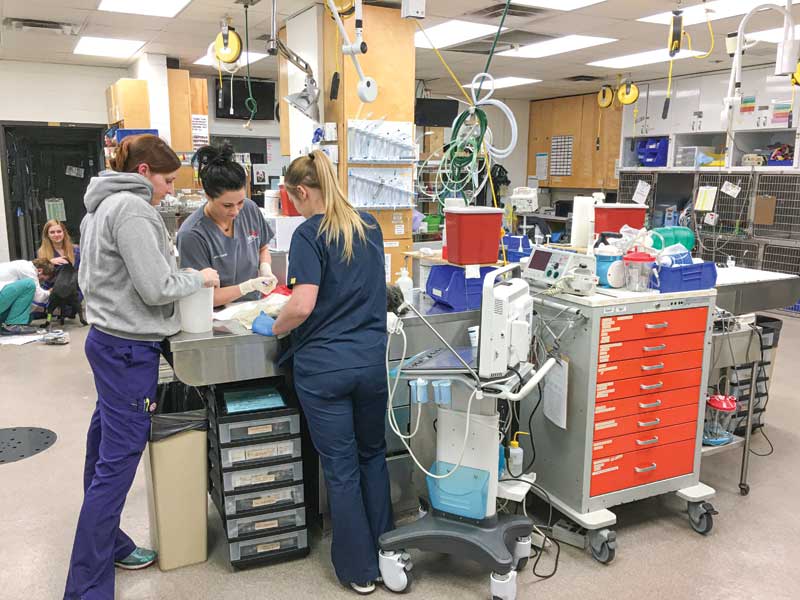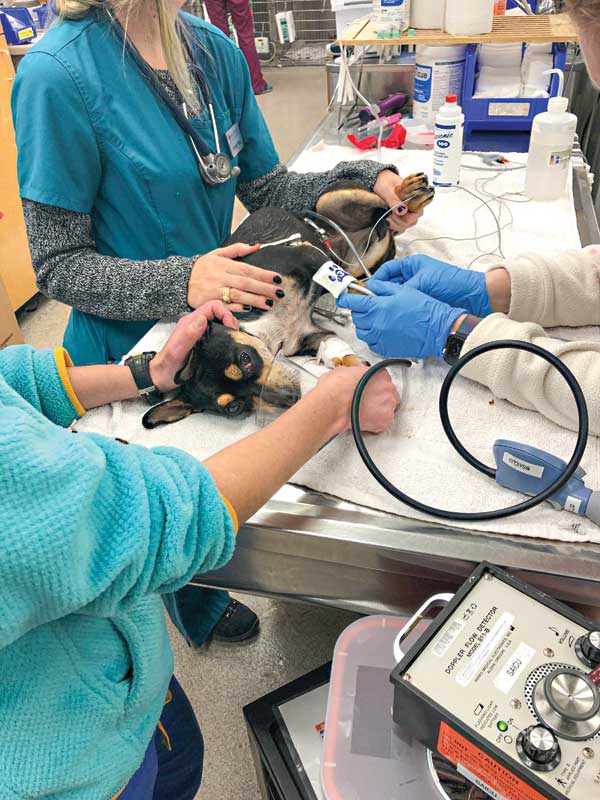
The term “triage” comes from the French word trier, which means “to sort.” The practice of triage began on European battlefields in the 1800s, as large numbers of injured soldiers needed treatment at the same time, while only limited resources were available. Nowadays, in veterinary medicine, triage is the sorting of patients for treatment priority when resources are insufficient to treat all emergency patients simultaneously.
An efficient and quick triage should be implemented on every emergency patient presented to a veterinary facility, allowing for rapid identification of the urgent problems and the ability to provide immediate treatment of potential life-threatening conditions.
Who do we need to triage?
To implement a triage system in a veterinary practice, it is first important to recognize which criteria will be used to determine if triage should be performed.
In the ideal world, an efficient and quick triage should be performed on every sick patient presented to a veterinary facility. Each practice can, however, decide which patients will require a triage upon presentation. In both general and specialty practices, it is reasonable to triage any patient that requires a “same-day” appointment or referral due to illnesses. Any walk-in emergencies should, however, always be triaged upon presentation. A rapid and systemic approach of any emergency patient will allow the veterinarian to assess the severity of its condition and create an initial treatment and diagnostic plan efficiently.
Triage can be performed by any trained person from the health care team, be it veterinary student, trained technician, or veterinarian. It can begin over the phone by gaining signalment and brief history prior to the patient’s arrival and be continued once the patient arrives. If triage is performed over the phone, it is recommended to have a set list of questions that the receptionist will ask prior to arrival. This allows the team to be prepared when the patient arrives. It is also useful to have an estimate of costs for stabilization and initial assessment for unstable patients that can be communicated to the owner over the phone or upon arrival. Upon patient presentation, triage can be performed in the reception area, in a consultation room or in a dedicated triage area.
How to triage?
Multiple triage systems exist (See “Triage, two ways”), offering different degrees of complexity and approach. Despite their differences, all triage systems include these steps:
1) Signalment, presenting complaints, and brief history
Noting the breed, age, and sex of the presenting animal helps limit the differential diagnoses. The presenting complaints provide invaluable information and are important parts of the triage process.
Additionally, a brief history taken from the owner at the time of presentation is essential. Without a history, clinical signs yet to manifest can be overlooked. This is especially important for animals presenting for toxin ingestion, as these are time-sensitive cases and decontamination procedures should begin immediately. Signalment, presenting complaints, and brief history, however, are prelude to the more important assessment of the emergency patient.
2) Brief physical assessment
The brief physical assessment or primary survey focuses on mentation, as well as the respiratory and cardiovascular systems. The physical assessment usually begins with mentation—observing the animal’s interaction with its environment. Is the animal alert and responsive? Can it stand and walk, or is it laterally recumbent? These observations can be made while taking the brief history.
The person doing the triage should then focus on the respiratory system. Does the animal have a normal respiratory rate and effort? Any respiratory distress should be considered a priority for immediate treatment. After assessing respiratory pattern, the cardiovascular system is assessed by checking perfusion parameters, such as heart rate, mucous membrane color, capillary refill time, and pulse quality. A patient suspected of being in shock should be considered top priority and be given immediate treatment.
Other conditions requiring immediate attention include seizure activity, open wounds with active bleeding, severe hypothermia and hyperthermia/fever, traumatic injuries, toxin ingestion, severe pain, unsuccessful attempts to urinate, and environmental-caused emergencies, such as heat stroke, injuries from fire, drowning, electrocution, or snake bite.
Triage, two waysChoose a system that will work best for your practice. Below are examples of triage systems: 1) ABCD 2) Five points triage system In 2012, a study modified this system for use in cats and dogs.1 In this veterinary five-points triage system, the technician or the clinician uses a veterinary triage list containing 68 discriminators divided in eight subcategories (respiratory, circulatory, neurological, trauma, gastrointestinal, obstetrical, urogenital, and generalized) to categorize patients in one of the five triage groups. In this situation, a discriminator represents the signs and symptoms used to discriminate patient between the five triage categories. Despite the complicated nature of this triage system, it may provide more specific guidelines for technicians to follow and offer a more homogeneous and consistent assessment of emergency patients. |
Implementation
To be successful with your triage system, make sure your team stays consistent and sticks to the plan until it becomes a routine. A few months after implementation, adjustments can be considered to further tailor the triage system to the practice needs.
Here are steps that can be followed to set up a personalized triage system:
Step 1: Deciding which patients will be triaged
Determine which patients will be triaged and create clear guidelines for the receptionists, technicians, and clinicians. This may include questions to ask owners on the phone prior to their arrival. Having some typical lines or a script of what to say to clients (on the phone or when they arrive) can help the client be more relaxed and prepared for the triage process. Having pets taken away quickly upon arrival can be difficult for owners, if they do not understand what is happening.
Step 2: Picking system
Choose a triage system that will best fit your practice. It may be quick and simple or more complex. If it is followed consistently, it will allow for great team efficiency. Remember to train the whole health care team expected to triage patients.
Step 3: Creating estimate and obtaining CPR status
Establish a typical “stabilization” estimate so the owners can agree to it immediately and not delay the care their pets need. This estimate should ideally include the initial assessment, blood pressure measurement, abdominal and thoracic Focused Assessment with Sonography for Trauma (FAST) scans, minimum data base blood work, administration of intravenous fluids, pain medication, oxygen flow-by, and antibiotics (if warranted).
Obtaining a CPR status will also be essential to guide the team if cardiopulmonary arrest occurs during the triage/stabilization period.
Step 4: Setting up a designated area
Once the animal is triaged as needing immediate care, it should be brought to a treatment area. By designating a space for patient stabilization, it is easier to ensure all materials and supplies are available. This will greatly affect the efficiency of the care provided.
Ideally, the treatment area should have a variety of emergency equipment, including materials for intravenous catheter placement, supplemental oxygen, fluid bags, and diagnostic equipment, such as electrocardiogram, indirect blood pressure measurement (oscillometric or doppler), pulse oximeter, and a small ultrasound machine. A fan and a temperature monitoring system are both useful to correct severe hypo- or hyperthermia. A crash cart is essential to recover patients from cardiopulmonary arrest.

Step 5: Having an action plan
When implementing a triage system, it is also vital to have a system in place once an unstable patient is recognized. What will happen after the triage phase? Who will be providing the care and/or performing diagnostics? Having a designated technician and clinician each day will assure a rapid and efficient handling of these cases. Communication will play an important role in the overall team efficiency and each practice should make sure they have an easy communication system in place (over paging system, phones, pager, etc.).
Point-of-care testing (POCT) can be implemented as part of any standard assessment and stabilization procedure. Minimal blood work should be performed in any unstable emergency patients to allow for rapid diagnosis of life-threatening conditions, such as hypoglycemia, anemia, or shock. Typical minimal blood work includes Big 4 (PCV/TS, Glucose, azostick) or Quick assessment tests (PCV/TS, Glucose, Lactate). Abdominal and thoracic FAST scans are designed to assess each cavity for the presence of free fluid and can also help rapidly diagnose potential life-threatening conditions, such as pleural effusion, pericardial effusion, hemoabdomen, and uroabdomen. Consider creating an assessment form where your team can easily gather all initial and pertinent information, such as vital parameters, blood work, and FAST scans results, and list all treatment received or initiated.
A well-planned and designed triage system will allow you to take your practice to the next level and to get your team ready to manage future emergencies efficiently and to offer the best care possible in a timely fashion.
Virginie Wurlod, Dr. vet. Med., DACVECC, DECVECC, is an associate professor in small animal Emergency and Critical Care at Louisiana State University. She is originally from Switzerland, where she did her initial veterinary training before pursuing an ECC residency in the U.S.
References
- Ruys LJ, Gunning M, Teske E, et al. Evaluation of a veterinary triage list modified from a human five-point triage system in 485 dogs and cats. J Vet Emerg Crit Care (San Antonio). 2012 Jun;22(3):303-12.
- Donnelly E, Lewis D, Triage of the veterinary patient. In Practice 2016;38:6-11.
Davis H. Triage, In: Burkitt Creedon J.M, Davis H, editors. Advanced Monitoring and Procedures for Small Animal Emergency and Critical Care. John Wiley & Sons, Inc. 2012, pp. 5-10. - Reineke EL, Evaluation and Triage of the Critically Ill Patient In: Silverstein DC, Hopper K, editors. Small Animal Critical Care Medicine. 2nd ed. St. Louis: Saunders; 2014, pp. 1-5.
- Sigrist N, Triage. In: Drobatz K, Hopper K, Rozanski E, Silverstein D, editors. Textbook of Small Animal Emergency Medicine. 1st ed. Wiley;2019, pp. 6-10.
